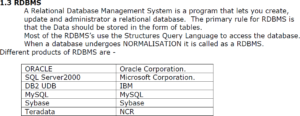Large-scale online transaction processing (OLTP), data warehousing, and e-commerce applications are all supported by Microsoft SQL Server. Additionally, it is a business-intelligent platform for reporting, analysis, and data integration.
Introduction to Database:
Data: A collection of facts, such values or measurements, is called data. It could include of words, numbers, measurements, observations, or just a list of things.
Database: A database is a collection of data that has been arranged and saved.
DBMS: Databases are made so that every user can access any data with just one set of software tools. A collection of computer programs that serves as a database or databases’ user interface is called a “database management system” (DBMS).

SQL Server Constraints
A constraint is a rule that database users are not allowed to violate. You can impose constraints on your database using SQL Server constraints. Table architecture, database integrity, and/or business logic may all be impacted by these regulations. They are all essential to the way your database is designed. There are five different sorts of limitations that Microsoft SQL Server supports:
1. NOT NULL:
Using NOT NULL constraints, you can tell a column not to contain NULL values. SQL Server looks for NULL values in a database column’s current contents before applying a new NOT NULL constraint. The constraint cannot be created if the column currently contains NULL values. Any further INSERT or UPDATE instructions that result in the existence of a NULL value fail in this scenario because SQL Server inserts the NOT NULL constraint.
-
UNIQUE:
SQL Server administrators can specify that a column cannot have duplicate values by using UNIQUE constraints. SQL Server looks for duplicate values in the corresponding column when you add a new UNIQUE constraint. The constraint creation command fails if duplicate records are already present in the table. A UNIQUE constraint on a column prevents attempts to add or modify data that would cause duplicates to already exist.
3.Primary key:
The purpose of primary keys is to guarantee that every record in a table has a distinct value in a column or collection of columns. A combination of not-null and unique constraints serves as the main key restriction. The database’s ability to uniquely identify each record allows for the assurance of data integrity. Rows in the primary key columns cannot contain null values, and a table may only have one primary key constraint. It is possible to add a primary key constraint after the table is created or to specify one afterwards.
4.CHECK:
The kinds of data that users can add to a database can be restricted using CHECK constraints. They go beyond data types by giving you the option to define the precise values that can be present in a column.
5.Foreign key:
Based on the values of columns in another table, this constraint limits the values of columns in one table. The two tables must be connected using a “lookup table,” which contains the approved list of values and needs to have a unique or primary key constraint. Any changes or additions to the fields listed in the foreign key table constraint will cause a validation to ensure the data is actually present in the lookup table once the constraint between the two tables has been set.